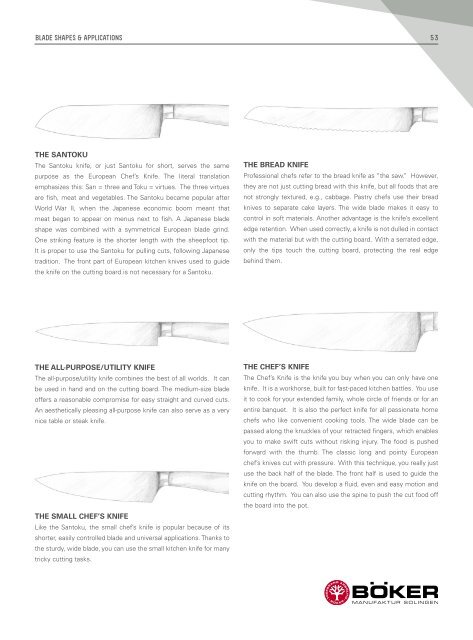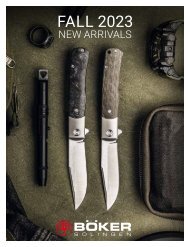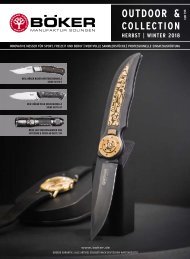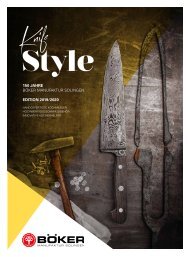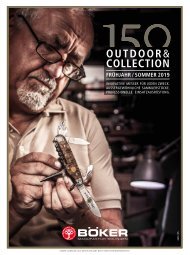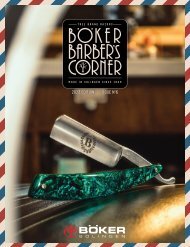Boker Knifestyle | EN Edition 2018 / 2019
You also want an ePaper? Increase the reach of your titles
YUMPU automatically turns print PDFs into web optimized ePapers that Google loves.
BLADE SHAPES & APPLICATIONS<br />
53<br />
THE SANTOKU<br />
The Santoku knife, or just Santoku for short, serves the same<br />
purpose as the European Chef’s Knife. The literal translation<br />
emphasizes this: San = three and Toku = virtues. The three virtues<br />
are fish, meat and vegetables. The Santoku became popular after<br />
World War II, when the Japanese economic boom meant that<br />
meat began to appear on menus next to fish. A Japanese blade<br />
shape was combined with a symmetrical European blade grind.<br />
One striking feature is the shorter length with the sheepfoot tip.<br />
It is proper to use the Santoku for pulling cuts, following Japanese<br />
tradition. The front part of European kitchen knives used to guide<br />
the knife on the cutting board is not necessary for a Santoku.<br />
THE BREAD KNIFE<br />
Professional chefs refer to the bread knife as “the saw.” However,<br />
they are not just cutting bread with this knife, but all foods that are<br />
not strongly textured, e.g., cabbage. Pastry chefs use their bread<br />
knives to separate cake layers. The wide blade makes it easy to<br />
control in soft materials. Another advantage is the knife’s excellent<br />
edge retention. When used correctly, a knife is not dulled in contact<br />
with the material but with the cutting board. With a serrated edge,<br />
only the tips touch the cutting board, protecting the real edge<br />
behind them.<br />
THE ALL-PURPOSE/UTILITY KNIFE<br />
The all-purpose/utility knife combines the best of all worlds. It can<br />
be used in hand and on the cutting board. The medium-size blade<br />
offers a reasonable compromise for easy straight and curved cuts.<br />
An aesthetically pleasing all-purpose knife can also serve as a very<br />
nice table or steak knife.<br />
THE SMALL CHEF’S KNIFE<br />
Like the Santoku, the small chef’s knife is popular because of its<br />
shorter, easily controlled blade and universal applications. Thanks to<br />
the sturdy, wide blade, you can use the small kitchen knife for many<br />
tricky cutting tasks.<br />
THE CHEF’S KNIFE<br />
The Chef’s Knife is the knife you buy when you can only have one<br />
knife. It is a workhorse, built for fast-paced kitchen battles. You use<br />
it to cook for your extended family, whole circle of friends or for an<br />
entire banquet. It is also the perfect knife for all passionate home<br />
chefs who like convenient cooking tools. The wide blade can be<br />
passed along the knuckles of your retracted fingers, which enables<br />
you to make swift cuts without risking injury. The food is pushed<br />
forward with the thumb. The classic long and pointy European<br />
chef’s knives cut with pressure. With this technique, you really just<br />
use the back half of the blade. The front half is used to guide the<br />
knife on the board. You develop a fluid, even and easy motion and<br />
cutting rhythm. You can also use the spine to push the cut food off<br />
the board into the pot.


